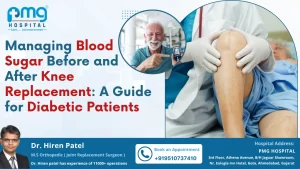
Managing Blood Sugar Before and After Knee Replacement: A Guide for Diabetic Patients
Knee replacement surgery can help you move more easily and reduce long-term pain. It is more impactful especially when you
Welcome To PMG Hospital
PMG Hospital is a modern orthopedic hospital that offers high-quality care with the latest medical equipment. It focuses on joint replacement surgeries like knee, hip, and shoulder replacements. If you’re looking for the best orthopedic surgeon/hospital in Ahmedabad, PMG Hospital provides expert treatment to help you recover faster and move better.




Dr. Hiren Patel is Ahmedabad’s best joint replacement surgeon. In a young career orthopedic doctor has already performed more then 11,000+ joint replacement surgeries. His expertise served in renowned Gujarat’s hospitals like CIMS, EPIC Hospital, SGVP Hospital & Neuro1. Currently he is director and head joint replacement surgeon at PMG Hospital, Ahmedabad.
Passion and determination has made his name in complex and Revision knee and hip replacement surgeries. Dr. Hiren has committed his career to assisting patients in achieving the greatest outcomes while maintaining the highest levels of safety and comfort.
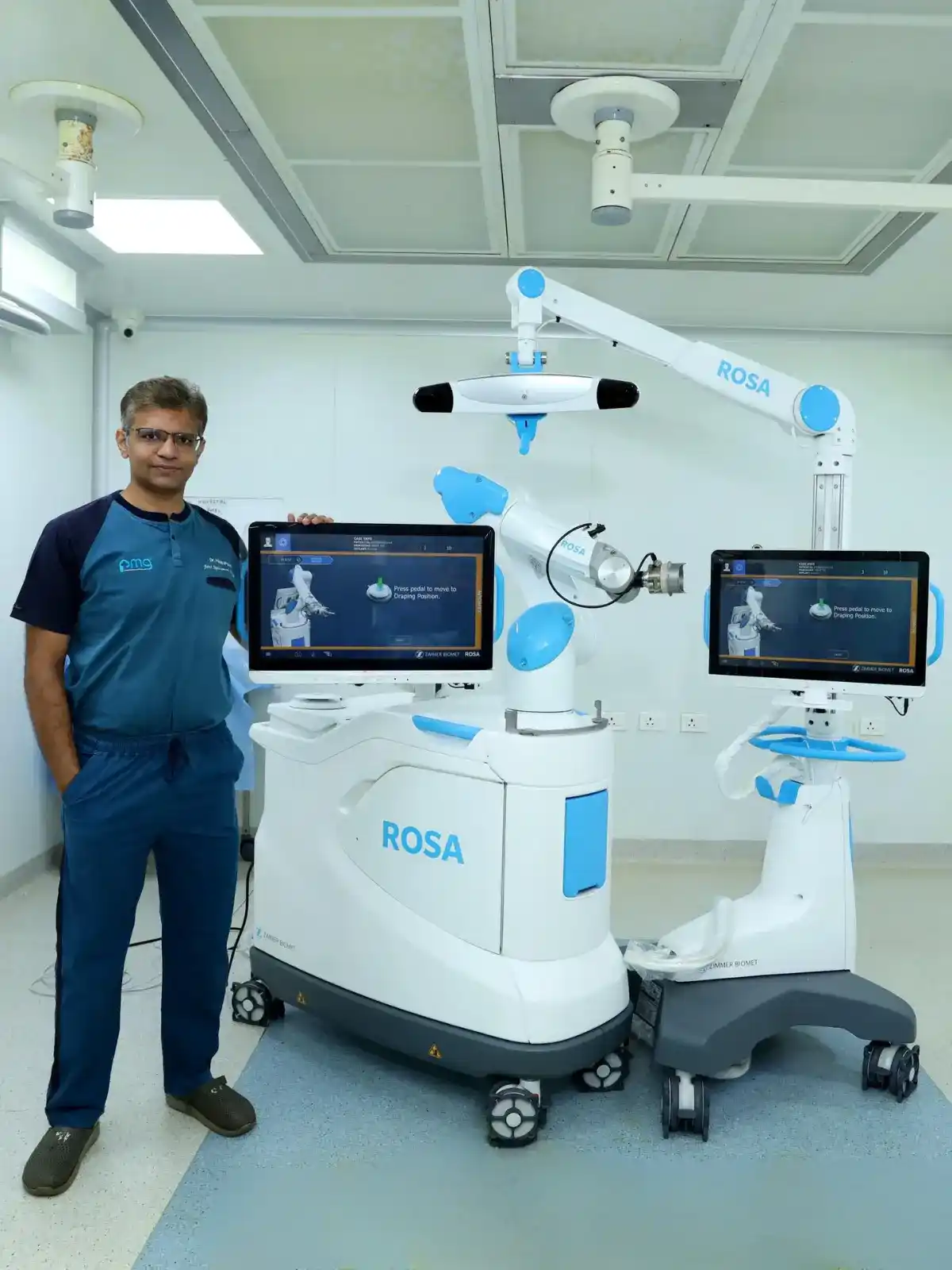
One Smart Step Ahead in Knee Replacement Surgery
ROSA is a less invasive & simplified Robotic-assisted Knee Joint replacement procedure to improve surgical performance and clinical outcome of knee replacement surgery.
This is surgical procedure involves removing the knee joint’s worn-out or damaged surfaces and replacing them with artificial implants
Total hip replacement is a surgical procedure in which the damaged cartilage and bone is removed from the hip joint and replaced with artificial components
A shoulder replacement is a procedure that replacing damaged parts of the shoulder joint with artificial components called prostheses
A major bone or muscle injury from an external force, such as a fall or vehicle collision, is referred to as orthopaedic trauma
A minimally invasive procedure known as a “partial knee replacement” replaces the damaged compartment of the knee with an implant
One of the main ligaments responsible for supporting the knee is the anterior cruciate ligament (ACL). Surgery to repair a torn ACL is known as ACL reconstruction
Arthroscopy is a minimally invasive procedure that looks within a joint with a camera. A variety of orthopedic illnesses that might lead to joint pain or mobility issues are diagnosed & treated using arthroscopy
Knee replacements occasionally fail for a variety of reasons. The goal of revisional knee replacement surgery is to replace your old knee implant in whole or in part with a new one
Technology & transportation has made this world smaller. So in this modern era, to get the best affordable medical treatment, boundaries can not be barrier. Advance medical facilities, affordable & accurate medical treatment made India global medical tourism destination in past decade. Therefore, if orthopedic treatments in your own country are expensive and time-consuming, PMG Hospital is your best option for receiving orthopedic treatments including knee, hip, and shoulder replacement surgeries at reasonable prices while still ensuring complete healing and safety. Rest assured our international patient care team will take care of you and your family members in each every aspect to get the best treatment.

Unmatched Expertise
Dr. Hiren Patel has successfully carried out 11000+ joints surgeries
High Class Facility
PMG Hospital is advance orthopedic surgical center with an advance medical facilities
Precise Result
PMG team's expertise and experience always brings out precise result
Qualified Staff
Qualified, skilled medical staff is 24 * 7 available for you since your arrive
At PMG Hospital, we are committed to offering our patients the most advance and proven methods for orthopadic surgeries and post operative recovery. We are experts in all facets of hip and knee replacement surgery, including total joint replacement, partial joint replacement, revision of failed hip and knee replacement, and orthopedic arthroscopy procedures. PMG is best orthopedic hospital in Ahmedabad.
Here we will keep you updated with the latest news and events happening at The PMG Orthopedic Hospital

Knee replacement surgery can help you move more easily and reduce long-term pain. It is more impactful especially when you
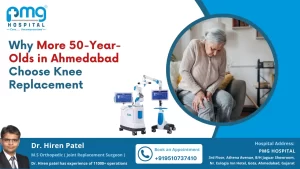
In the old days, knee replacement was seen as a last option for old age people who have constant knee
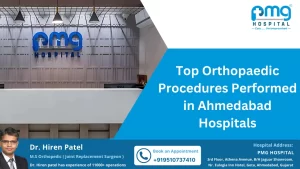
Nowadays, Orthopedic treatment has become more advanced and safe as compared to older days in India. Because of the latest
The number of orthopedic patients we treat each year is evidence of the high calibre of our offerings. Here are some of the patient testimonials that PMG has had the honour of helping them.
Dr. Hiren Patel is Ahmedabad’s leading orthopedic doctor. Throughout his career of 13 years, Dr. Patel has consistently exhibited a dedication to his patient’s well-being, working tirelessly to ensure that they receive the highest quality care. With his expertise and experience, patients can trust that they are in capable and caring hands when they choose Dr. Hiren Patel as their orthopedic surgeon. He specializes in knee, hip and shoulder replacement surgeries, trauma surgery, and ACL reconstruction, and offers minimally invasive techniques. If you have musculoskeletal abnormalities or orthopedic problems and looking for expert orthopedic Doctor in Ahmedabad then Dr. Hiren Patel, Director and head Orthopedic Surgeon at PMG Hospital, is the finest accessible option.
What does a person entail in order to choose the best orthopedic hospital in Ahmedabad? He or She is looking for experienced orthopedic doctors, modern medial infrastructure, Skilled hosptial staff. PMG Hospital exceeds all of your expectations !!
At PMG hospital, we are committed to providing comprehensive care for all of our patients. Our core services include knee, hip and shoulder replacements, fracture (trauma) surgeries, ACL reconstructions and many more.
PMG Hospital is NABH Certified orthopedic hospital in Ahmedabad, which gives you assurance for the highest standards of quality and safety are maintained.
The cost of knee replacement surgery can vary widely depending on several factors, including the country and region where the surgery is performed, the specific hospital or surgical center, the surgeon’s fees, the type of implant used, and any additional medical expenses.This estimate generally includes the surgeon’s fee, hospital stay, anesthesia, pre-surgery consultations, and post-surgery physical therapy. Insurance coverage can significantly affect the out-of-pocket cost for patients, so it is important to check with your insurance provider for specific details regarding coverage and potential expenses. Additionally, some hospitals and surgical centers may offer bundled pricing or financing options to help manage the cost of the procedure.
The main difference between partial and total knee replacement lies in the extent of the surgery and the parts of the knee joint that are replaced:
Partial Knee Replacement (PKR):
Total Knee Replacement (TKR):
You may need knee replacement surgery if you experience the following conditions and symptoms:
Severe Knee Pain: Persistent pain that limits your daily activities, such as walking, climbing stairs, and getting in and out of chairs. This pain may also interfere with your ability to sleep.
Stiffness and Limited Mobility: Reduced range of motion in your knee that makes it difficult to bend or straighten your leg fully.
Swelling and Inflammation: Chronic swelling and inflammation that do not improve with rest, medication, or other treatments.
Deformity: Noticeable bowing or other deformities in the knee joint.
Failed Conservative Treatments: Lack of improvement despite trying non-surgical treatments such as medications, physical therapy, weight loss, corticosteroid injections, and other interventions.
Impact on Quality of Life: Significant impact on your quality of life, preventing you from performing everyday activities and enjoying your usual hobbies and interests.
Advanced Arthritis: Diagnosis of advanced osteoarthritis, rheumatoid arthritis, or other degenerative joint diseases confirmed by X-rays and other imaging studies showing severe joint damage.
Hospital Stay: Most patients stay in the hospital for 1 to 3 days after surgery. During this time, you will begin physical therapy to start moving your knee and walking with assistance.
First Few Weeks:
Months 2-3:
Months 3-6:
Full Recovery:
An ideal patient for knee replacement surgery typically exhibits the following characteristics:
Severe Knee Pain and Stiffness: Experiences chronic, severe knee pain and stiffness that significantly limits daily activities, such as walking, climbing stairs, and performing household chores. Pain may also interfere with sleep.
Failed Conservative Treatments: Has tried and not found relief from non-surgical treatments such as medications, physical therapy, corticosteroid injections, weight loss, and lifestyle modifications.
Advanced Knee Arthritis: Diagnosed with advanced osteoarthritis, rheumatoid arthritis, or post-traumatic arthritis, confirmed through imaging studies (X-rays, MRI) showing substantial joint damage.
Reduced Quality of Life: Has a significantly diminished quality of life due to knee pain and mobility limitations, affecting their ability to work, exercise, and engage in social activities.
Functional Limitations: Struggles with knee function despite using assistive devices like canes or walkers and finds it difficult to perform essential tasks independently.
Age and Health: Generally, patients between the ages of 50 and 80 are considered good candidates, though younger and older patients can also benefit from the surgery if they are in good health and the knee condition severely impacts their life. The patient should be healthy enough to undergo surgery and anesthesia.
Realistic Expectations: Understands the risks and benefits of knee replacement surgery, has realistic expectations about the outcomes, and is committed to participating in post-operative rehabilitation to ensure the best possible recovery.
Yes, physiotherapy is essential after knee replacement surgery. It plays a crucial role in the recovery process and helps ensure the best possible outcomes. Here are the key reasons why physiotherapy is necessary:
Restores Mobility: Physiotherapy helps restore range of motion in the knee, allowing you to bend and straighten your knee fully.
Strengthens Muscles: Exercises prescribed by a physiotherapist strengthen the muscles around the knee, which is vital for supporting the new joint and improving overall stability and function.
Reduces Swelling and Pain: Physiotherapy techniques, including specific exercises and modalities like ice therapy, help reduce post-operative swelling and pain.
Improves Balance and Coordination: Therapy includes exercises that improve balance and coordination, reducing the risk of falls and enhancing overall mobility.
Promotes Healing: Guided physical therapy accelerates the healing process by increasing blood flow to the area, which aids in tissue repair and recovery.
Prevents Complications: Regular movement and exercise help prevent complications such as blood clots, joint stiffness, and muscle atrophy.
Achieves Functional Goals: Physiotherapists tailor rehabilitation programs to meet individual goals, whether it’s returning to daily activities, sports, or specific occupational tasks.
Enhances Long-Term Outcomes: Commitment to physiotherapy can improve the long-term success of the knee replacement, ensuring the joint remains functional and pain-free for as long as possible.
The best implant for knee replacement depends on various factors, including the patient’s age, activity level, medical history, and specific needs. There is no one-size-fits-all answer, but here are some commonly used types of knee implants and their features:
Metal-on-Polyethylene (MoP):
Ceramic-on-Polyethylene (CoP):
Ceramic-on-Ceramic (CoC):
PMG Hospital is best orthopedic hospital in Ahmedabad for knee replacement, hip replacement, Trauma surgeries & Arthroscopy treatments.
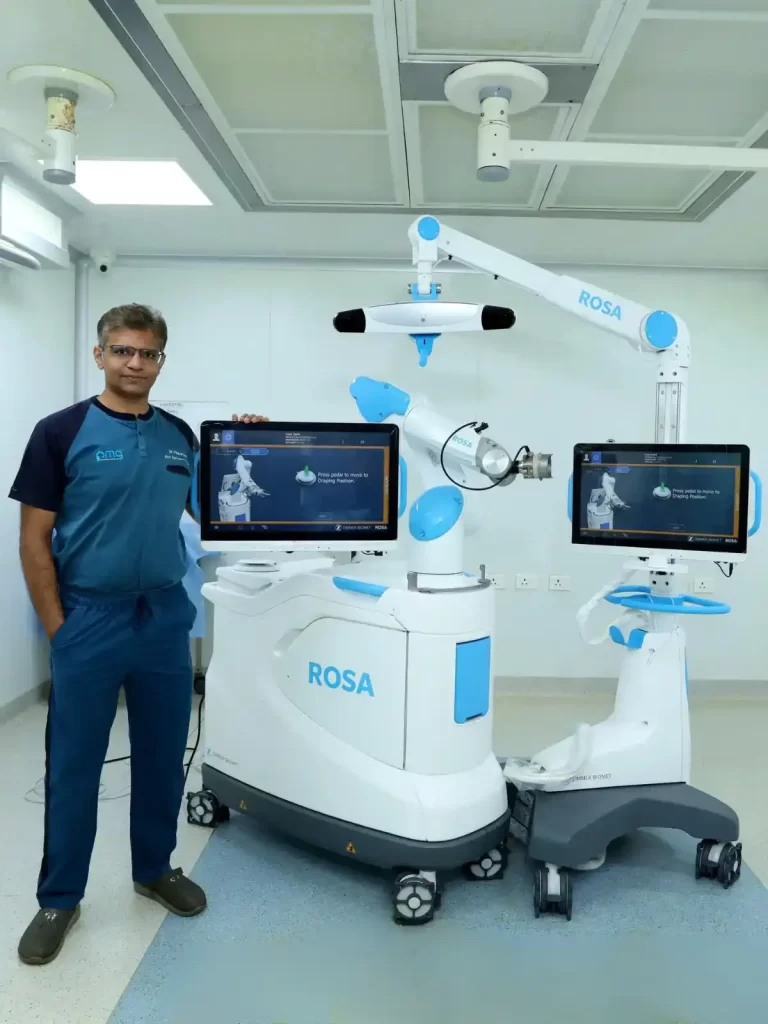
One Smart Step Ahead in Knee Replacement Surgery
At PMG Orthopedic Hospital, we are dedicated to delivering the highest quality care to our patients. Leveraging the latest advancements in robotic knee replacement technology, we offer a minimally invasive procedure that promotes quicker recovery, reduced pain, and more precise results. Our facility is equipped with the cutting-edge ROSA robotic system (Zimmer Biomet, USA), which allows us to customize each knee replacement surgery based on your unique anatomy. This tailored approach ensures greater precision, shorter hospital stays, and a faster return to your everyday activities. If you’re struggling with knee pain or joint problems, trust us to help you restore mobility with the most advanced robotic knee replacement surgery. Your well-being is our priority!